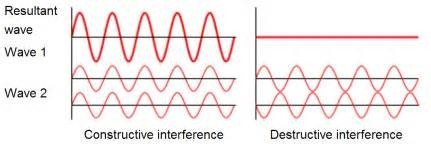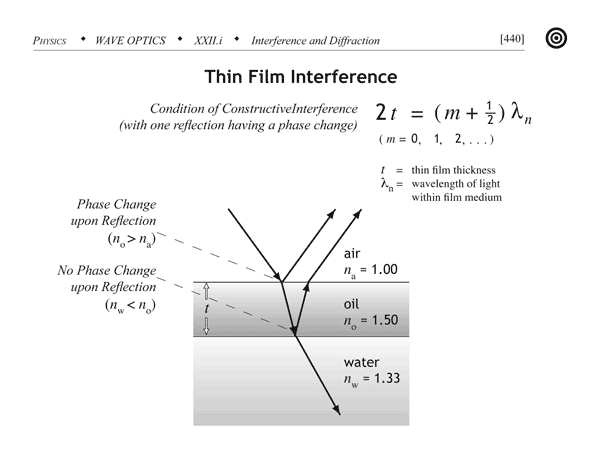What causes the rainbows in a shallow puddle of oil? Why doesn't the surface of a barrel of oil shimmer in the same way?

The key lies in a phenomenon called thin film interference.
Interference
When waves of any type overlap, interference occurs. Electromagnetic waves such as light are no different, and the amplitude (total height) of the resultant waves is the sum of the constituent wave amplitudes - this rule is the principle of wave superposition.
If wave A at a given point is a peak and wave B at the same point is a trough, the two waves destructively interfere and the resultant wave amplitude is closer to, or equal to, zero.
If the two waves are both at peaks at a given point, constructive interference occurs and the resultant wave at that point is of far greater amplitude than either constituent wave.

Thin Films
Light incident to a boundary surface partially reflects, with the rest being transmitted across the boundary. Reflected light is shifted by half a cycle if the new material has a greater refractive index (see my articles Images In A Spoon and Why We Need Glasses for explanations of refractive indices) than the previous material. Assuming the light was near-perpendicular to the surface, the extra distance travelled by a refracted light ray (as opposed to the reflected light ray) is 2d - where d is the thickness of the film.

Reflection and refraction within a thin film
Taking into account a half-cycle phase shift, since oil has a greater refractive index than air, the most constructive interference will occur when the wavelength of the light wave is satisfied by the below conditions:

Conversely, destructive interference occurs most when 2t = m?, again assuming a boundary phase shift.
At a given point, a person looking at a gas station oil slick will perceive incident light rays of wavelength (colour) which satisfy constructive interference during reflection-refraction as brightest (most intense), and wavelengths conducive to destructive interference will not be seen - they are, in effect, 'cancelling out'.
Thin films such as oil slicks are in reality never uniform in thickness. This means that different colours of light will interfere constructively/destructively to different degrees throughout the material (d in our equation in changing, so ? is also changing). A uniform slick would be uniformly coloured.
Thicker Films
Thick films - a barrel of oil, for example - do not produce colourful patterns because the intensity of refracted light is greatly diminished with distance (a deeper barrel means a greater distance is travelled by refracted light). At thicknesses of more than a few wavelengths, interference due to reflection-refraction superposition is negligible.
Non-reflective Coatings
Many surfaces, such as lenses, require a non-reflective character. A coating can be applied of such a thickness - usually one quarter of the targeted wavelength's light - that complete destructive interference occurs to a desired colour of light, usually whichever incident light wavelength is most abundant.
Reflective Surfaces
Conversely, deliberately reflective surfaces such as mirrors employ a coating of thickness such that the net phase shift accommodates completely constructive interference in the desired wavelength of light.
For mirrors, this is actually green light - your bedroom mirror reflects green light most effectively.
If you enjoyed this article or are interested in all things science, follow my blog for daily doses of physics and chemistry, along with explanations for curious everyday phenomena.
References:
University Physics with Modern Physics by Young and Freedman
http://www.explainthatstuff.com/thin-film-interference
http://physics.bu.edu/py106/notes/Thinfilm.html
http://www.phys.ufl.edu/courses
http://www.physicsclassroom.com/class/light/Lesson-1/Thin-Film-Interference
Please continue writing! Your articles are great! :)
Thanks!
Awesome / Upvoted / Resteemed (-: ... great picture too.
Glad you enjoyed!
LoL I made a similar post on this. Only I was inspired by a puddle with oil and was more interested in the partition coefficient.
I'll be sure to read it - hope you enjoyed this one.
The post I mentioned is not here on steemit hahaha, I should have mentioned that. I've been enjoying your posts, especially the one on the Rheology and Viscosity of Honey. Kep up the good work.